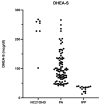Premature Pubarche: Time to Revise the Diagnostic Approach?
- PMID: 36983190
- PMCID: PMC10054674
- DOI: 10.3390/jcm12062187
Premature Pubarche: Time to Revise the Diagnostic Approach?
Abstract
Premature pubarche (PP) could represent the first manifestation of non-classic congenital adrenal hyperplasia caused by 21 hydroxylase deficiency (NC21OHD) (10-30% of cases). In the last 20 years, the necessity of performing an ACTH test to diagnose NC21OHD in all cases with PP has been questioned, with conflicting results. This study aims to retrospectively evaluate the predictive value of the basal androgens, 17-OHP levels, and auxological features in suggesting the presence of NC21OHD and, thus, the need for a standard ACTH test to confirm the diagnosis. In all, 111 consecutive patients (87 females) with PP and advanced bone age underwent an ACTH test. Of these, 6/111 cases (1 male) were diagnosed with NC21OHD. The mean baseline 17 hydroxyprogesterone (17-OHP), dehydroepiandrosterone (DHEA), dehydroepiandrosterone sulfate (DHEA-S), delta 4 androstenedione (Δ4A), and testosterone serum levels were higher in NC21OHD patients than in the others (p < 0.05). We found three predictive features for NC21OHD: basal 17 OHP of >200 ng/mL, bone age advance of >2 years, and DHEA-S levels of >228 ng/mL with sensitivity and specificity of 83.3% and 97.1%, 83.3% and 65.7%, and 83.3% and 96.2%, respectively. Our data confirm that the prevalence of NC21OHD is low among patients with PP. Serum 17-OHP of >200 ng/mL could be helpful to decide, in most cases, which patients should undergo the ACTH test. Bone age advance represented an inadequately specific predictive marker of NC21OHD.
Keywords: 17OH Progesterone; ACTH test; bone age; early pubarche; non-classic congenital adrenal hyperplasia.
Conflict of interest statement
The authors declare no conflict of interest.
Figures
References
-
- Sopher A.B., Jean A.M., Zwany S.K., Winston D.M., Pomeranz C.B., Bell J.J., McMahon D.J., Hassoun A., Fennoy I., Oberfield S.E. Bone Age Advancement in Prepubertal Children with Obesity and Premature Adrenarche: Possible Potentiating Factors. Obesity (Silver Spring) 2011;19:1259–1264. doi: 10.1038/oby.2010.305. - DOI - PMC - PubMed
LinkOut - more resources
Full Text Sources
Miscellaneous




